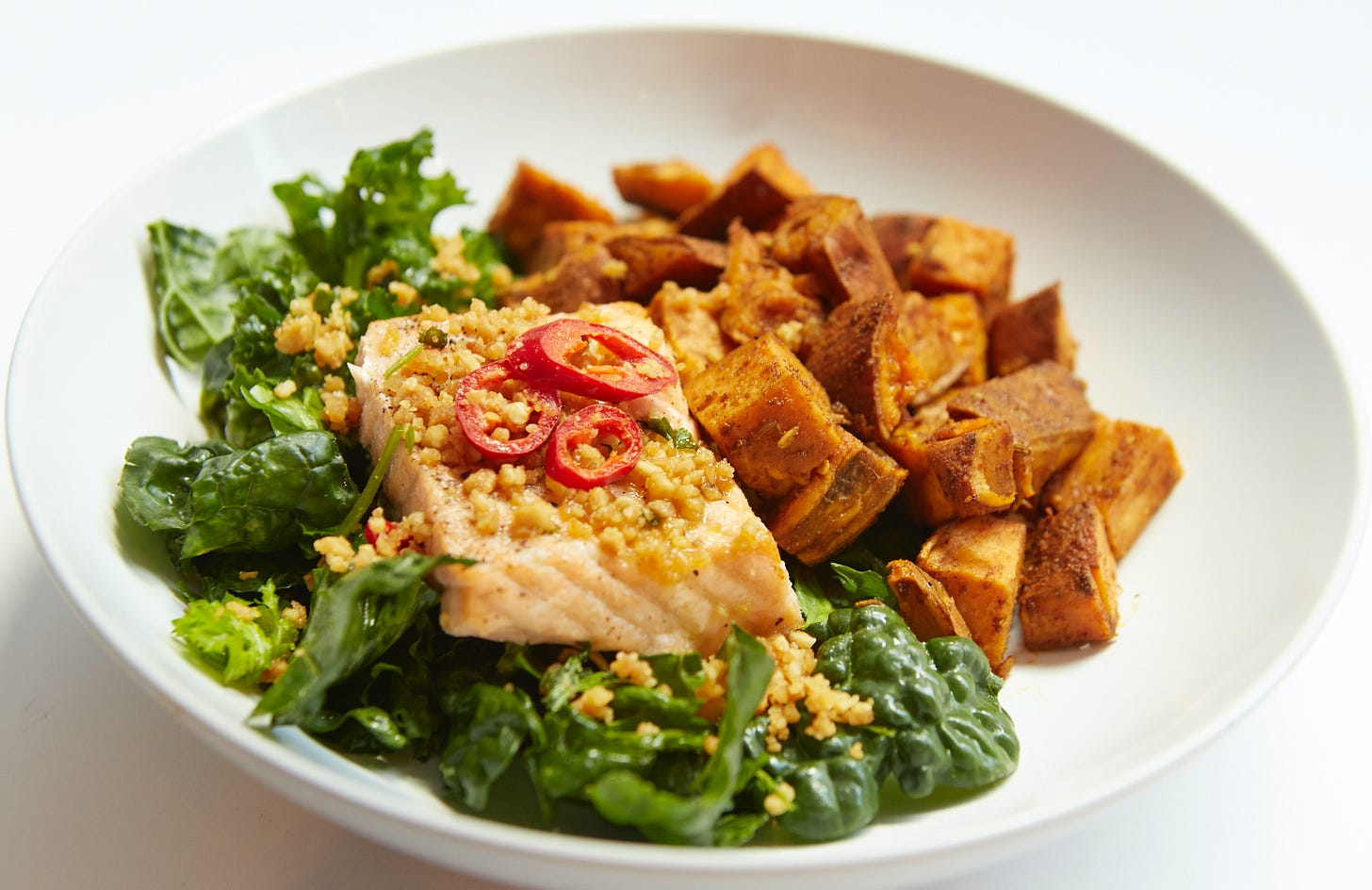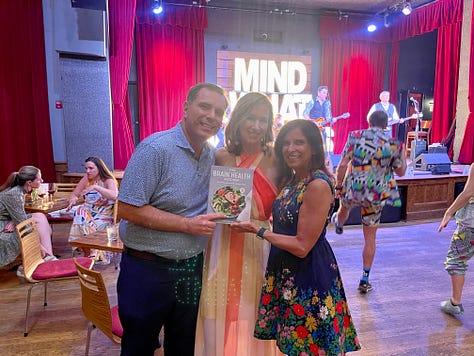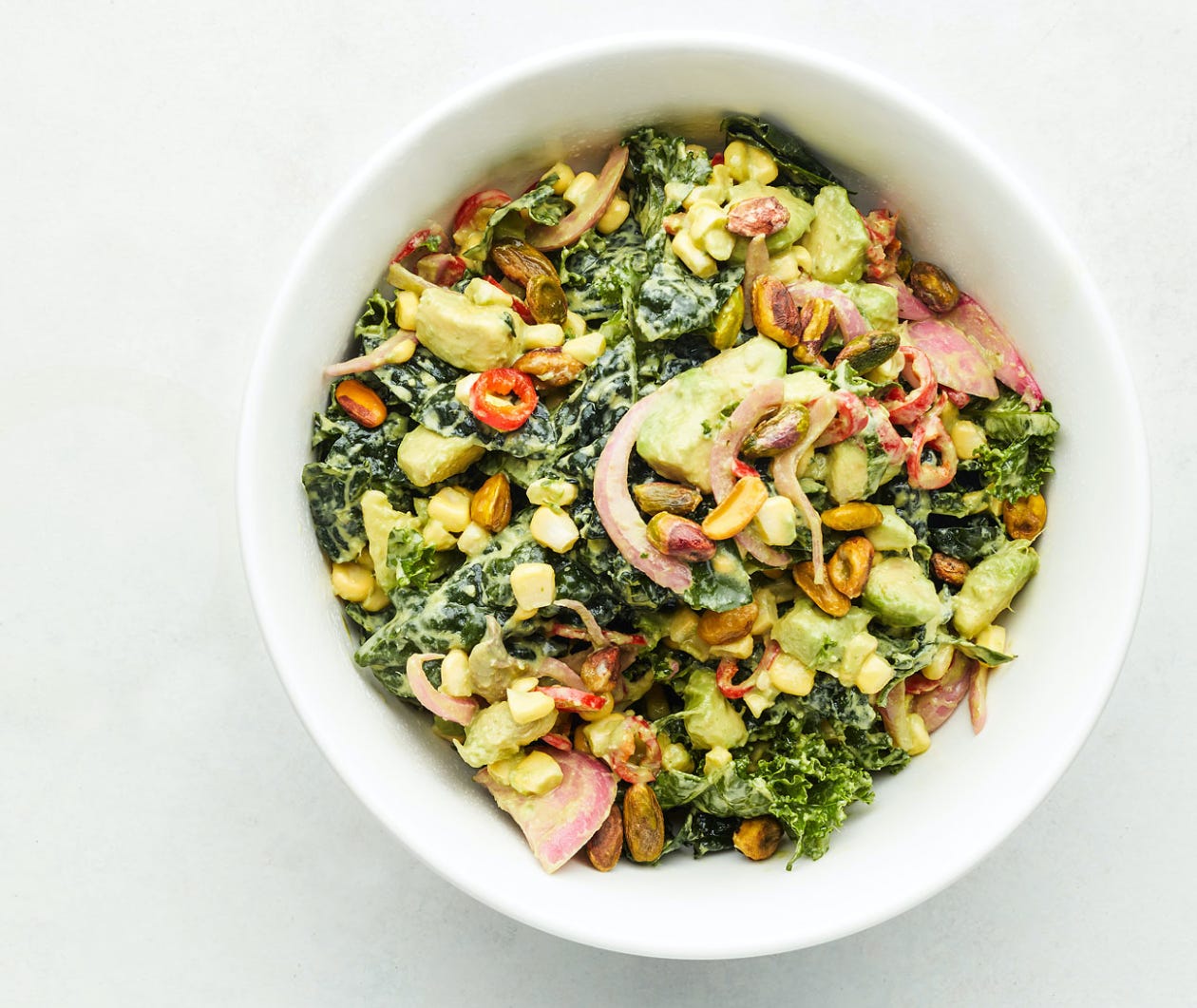Fiber Is More Important For Brain Health Than You Think
4 reasons to aim for at least 25 grams of fiber in a day, and 10 foods to get you there

Hello, Brain Health Ambassadors. I write to you today from my favorite place to eat in New York City—Honeybrains, a restaurant group focused on brain-healthy food. Yes, Honeybrains is a brain food restaurant! (Learn their origin story here and check out more of their dishes below.) It was inevitable that their CEO and co-founder Marisa Seifan and I became friends. Last night we were in conversation at the JCC in Manhattan for a collaboration between Brain Health Kitchen and Broadway’s Best for Parkinson’s: Boosting Brain Health with Food. If you missed it, I’ll be posting the recording soon.
A new way to think about fiber
If the word fiber conjures visions of cardboard-like crackers and psyllium powders stirred into juice, think again. Let’s reimagine fiber-rich to mean delicious and good for the brain—foods like avocados, sweet potatoes, berries, and even dark chocolate. Eating enough fiber is so critical for a brain-protective dietary pattern that I made it one of my 4F’s of brain-healthy food. (See below for a recap of the other F’s.)
Fiber: what it is

Fiber simply means a type of carbohydrate that the body can’t digest. While most people think of fiber as something to keep the gut moving, this macronutrient plays a key role in keeping your brain healthy, too. Working stealthily in the background of your body’s metabolic functions, fiber from food lowers blood sugar and harmful cholesterol, curbs appetite, and feeds the hungry microbes in your gut.
Soluble vs. Insoluble Fiber
There are two general categories of dietary fiber. Soluble fiber is found in foods like oats, chia seeds, nuts, beans, lentils, and some fruits and vegetables. Since it’s soluble, this type of fiber retains water and turns to gel during digestion—a good thing to slow digestion and enhance the absorption of nutrients from food. I like to think of the brain-healthy nutrients, especially flavonoids, as piggy-backing onto this type of fiber, giving them a wider platform to make it to the brain.
Insoluble fiber can be found in fruits with edible peel or seeds (like pears and flaxseed), vegetables, and whole grain foods (like farro, barley, brown rice, and oats, especially oat bran). One of the reasons I incorporate citrus peel into my recipes is to boost it with this insoluble fiber. (See: the Glazed Citrus Almond Olive Oil Cake in my book, which employs an entire lemon and orange.)
Fiber does these 4 things for your brain
Let’s take a look at how much fiber the body needs and what it can do for you, starting with your blood sugar.
Fiber blunts the blood sugar response
Paying attention to blood sugar is important for brain health. When there’s excess glucose (from breaking down carbohydrates from food), it wreaks inflammatory havoc on blood vessels and brain cells. We know that persons living with diabetes have an increased risk of Alzheimer’s. Borderline diabetes (defined as fasting blood glucose between 100 and 125 mg/dl) also increases dementia risk. Fiber in food slows down the absorption of sugar into the bloodstream so that it doesn’t elicit a spike in glucose (its breakdown product) or insulin (the hormone that decides where the glucose goes).
You may notice that whenever one of my recipes includes some form of sugar, it is balanced by fiber-rich ingredients. The Fudgy Quinoa Brownies, for example, strategically includes quinoa, almond flour, and dark chocolate (a surprising source of fiber, 3.5 ounces of 80% cacao chocolate provides 10 grams of fiber) to slow down absorption of the glucose in the maple syrup.
Fiber lowers LDL cholesterol
Did you know there’s a dietary pattern designed for lowering LDL cholesterol? The Portfolio diet is a plant-based diet that emphasizes eating fiber-rich foods (oats, barley, psyllium, eggplant, okra, apples, oranges, and berries), along with nuts and plant protein (such as soy foods). It has been shown to be effective in reducing LDL (the harmful type of cholesterol associated with increased Alzheimer’s risk) as much as taking a cholesterol-lowering drug.
Oat bran, for example, provides both soluble and insoluble fiber in a hefty dose—about 6 grams per cup (cooked). In this meta-analysis study, boosting the diet with oat bran resulted in a significant LDL-lowering effect.
Fiber makes you feel satiated after a meal, and so reduces the tendency to overeat
Why does a salad fill you up more than the same amount of calories in a bowl of processed cereal? Fiber, for one. Also, the act of chewing sends signals to your brain that soon you will be satiated.
One of the most amazing things about ingesting fiber-rich foods is that they can have a delayed effect on your appetite. Insoluble fiber travels to the lower part of the intestinal tract, feeding the microbiota who live there. They, in return, synthesize molecules that impact how hungry you are many hours, even a day, later. I go into this “Lentil Effect” on page 225 of my book.
Maintaining a healthy weight is an important factor in Alzheimer’s prevention. In a roundabout way, eating fiber-rich foods helps by making it nearly impossible to overeat.
The beneficial microbes in your gut need fiber to thrive
You’ve probably heard the terms prebiotic, probiotic, and postbiotic bandied around. (I went into the definitions in this article about gut health.) Prebiotic foods are rich in the types of fermentable fiber good microorganisms in your gut need to thrive. I think of these pods of good gut bugs as tiny factories cranking out beneficial substances for the brain. They synthesize neurotransmitters, for example, for cell to cell communication, and produce short chain fatty acids that quell inflammation.
Perhaps the most potent prebiotic you can eat is in the form of resistant starch—a type of food that “resists” digestion until it gets to the lower part of the gastrointestinal tract, where the health-promoting bacteria reside. A baked sweet potato, for example, develops resistant starch when chilled overnight in the fridge. Other foods that develop resistant starch after being cooked and cooled (and consumed cold) include oats, beans, brown rice, and whole grain pasta.
A general rule of thumb (based on results from the American Gut Project study) is to eat 30 or more different types of plant foods each week to cultivate a diverse and brain-supporting gut microbiome.
How much fiber do you really need?
Ninety-five percent of Americans don’t get the minimum recommended amount of fiber: 25 grams per day for women and 38 grams per day for men. Ultra-processed foods like packaged cookies and cakes, frozen pizza, and sweetened cereals are mostly to blame. According to a study published in Frontiers in Nutrition, more than 60 percent of caloric intake in the U.S. comes from ultra-processed food. Processing strips whole foods of their fiber content, along with minerals, vitamins, and healthy fats.
If you are an average sized woman, 25 grams of fiber may sound like a lot. But it’s not, especially if the bulk of your diet comes from whole, unprocessed foods. When in doubt: Choose whole plant foods as often as you can.
10 brain-healthy foods high in fiber you can eat every day (grams of fiber in parentheses):
1 piece whole-grain toast (about 3 grams). Bread that has the most fiber content will be labeled "100 percent whole grain" rather than just "wheat" or "multigrain."
1 cup oat bran (about 6 grams). Use it to make oatmeal, blend into a smoothie, or swap in some oat bran for oats in recipes (like my Whole Grain Chocolate Chip Cookies in the book.)
1 cup cooked steel cut oats with half an apple and a few walnuts (about 9 grams)
A big salad. 2 cups of leafy greens with ½ cup broccoli or cauliflower (about 7 grams), add 1 cup cooked quinoa for another 5 grams.
½-cup cooked chickpeas (about 5 g) or ½ cup hummus (about 7 grams)
1 cup cooked lentils (especially black beluga lentils), in soup, salad or the tacos I shared with you here (about 9 grams)
1 cup berries (about 8 grams), especially raspberries, blueberries, or strawberries
½ a medium baked sweet potato (about 5 grams). Sprinkle with 1/4 cup pistachios for another 3 grams.
½ a medium avocado (about 5 grams). Sprinkle with 2 tablespoons sesame seeds for another 18 grams.
¼ cup nuts, such as almonds or cashews (about 4 grams). Sprinkle atop 1 medjool date (pitted) for another 3 grams.
Do you struggle to get enough fiber?
What are some of your favorite fiber-rich brain foods?
Recap of the 4F’s of Brain-Healthy Food
I created this simple checklist to help you identify when a food is good for your brain. Each of the 4F’s of Brain-Healthy Food—fats, fiber, flavonoids, and fit— provide something your brain needs to thrive. And while there are surely exceptions to this rule (I haven’t come up with one, but maybe you will), a brain-healthy food will possess at least 2 of these four properties. If you remember the 4F’s, you’ll be able to cut through the noise and pick a food that’s good for your brain, every time.
Brain-friendly fats, for example, are the types of fat in food that are not only anti-inflammatory, they provide structure to repair brain cells as they age.
Fiber slows down the absorption of sugar and provides food for brain-boosting microbes.
Flavonoids are the brain health nutrients in food that combat oxidative stress. (I went into flavonoids in more detail here.)
Fit is how you make all these foods work with your lifestyle. (We talked about fit here.)
Book Tour Update



The Brain Health Kitchen book has been getting around! Last week I was in Nashville with many of my partners in Alzheimer’s awareness and prevention for the Mind What Matters non-profit event: MWM founder Liz Humphreys, author Travis Macy, and Neuroreserve founder Dr. Ed Park. We raffled off a book and I threw in a cooking class with me at my home in Jackson Hole. Rachel and Nick jumped on that and I can’t wait to cook with them in JH this summer!
I am headed to Boston tomorrow to be in conversation with Dr. Andrew E. Budson at Hummingbird books. Here’s the link for more information and tickets.
I hope you are all having a good week. I can’t wait to hear how everyone is boosting their meals with FIBER.
Love,
Annie







Grains and sweet potato sends my glucose through the roof. Any suggestions on how I can become more metabolically flexible?
What is the max for fiber? I eat a lot of veggies, berries and whole grains and it is easy to exceed 30g fiber in a day (I have to really stop myself from hitting 35+ grams). My digestion seems good and I feel good- but I don’t want to overdo it. I eat about 1400cal/day (I’m 5’7/5’8 and weigh in the high 120s if that matters).